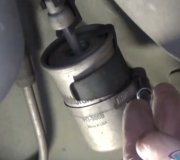Hi kegelmta, Welcome to 2carpros and TY for the donation
FUEL PRESSURE TEST
Reduce the internal pressure of the fuel pipes and hoses by the following procedures.
Open the trunk door and disconnect the fuel pump harness connector in the trunk room.
Start the engine and after it stalls, turn the ignition switch to the OFF position.
Disconnect the battery negative (-) terminal.
Connect the fuel pump harness connector.
Remove the bolt connecting the fuel line to the fuel delivery pipe. CAUTION: Cover the hose connecting with a shop towel to prevent splashing of fuel caused by fuel residual pressure in the fuel line.
Install the special service tool (SST) for measuring the fuel pressure.
Disconnect the fuel feed from the delivery pipe. CAUTION: Cover the hose connection with a shop towel to provent splashing of fuel caused by residual pressure in the fuel line.
Install the Fuel Pressure Gauge Adapter (09353-38000) between the delivery pipe and the fuel feed hose.
Connect the Fuel Pressure Gauge Connector (09353-38000).
Connect the Fuel Pressure Gauge and Hose (09353-24100) to the Fuel Pressure Gauge Connector (09353-24000)
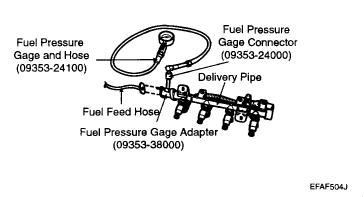
Connect the fuel feed hose to the Fuel Pressure Gauge Adaptor (09353-38000) Fuel pressure gauge to fuel delivery pipe 25 - 35 Nm (250 - 350 kg.cm, 18 - 26 lb.ft)
Connect the battery's negative (-) terminal.
Apply battery voltage to the terminal for the pump drive and activate the fuel pump: then, with fuel pressure gauge or connection part.
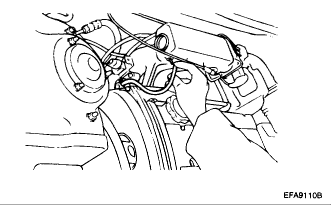
Start and run the engine at curb idle speed.
Disconnect the vacuum hose from the pressure regulator, and plug the end of the hose. Measure the fuel pressure at idle. Standard value: 320 - 340 kPa (3.26 - 3.47 kg/sq.cm, 46 - 49 psi)
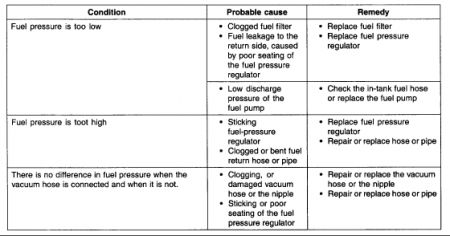
Measure the fuel pressure when the vacuum hose is connected to the pressure regulator. Standard value: Approx. 255 kPa (2.57 kg/sq.cm, 37 psi)
If the results of the measurements made in steps (7) and (B) are not within the standard value, use the table below to determine the probable cause, and make the necessary repairs.

Stop the engine and check for a change in the fuel pressure gauge reading, which should hold for approximately 5 minutes . If the gauge indication drops, observe the rate of drop. Determine and remove the causes according to the following table.
Reduce the pressure in the fuel line.
Disconnect the hose and the gauge. WARNING: Cover the hose connection with a shop towel to prevent splashing of fuel caused by fuel residual pressure in the fuel line.
Replace the O-ring of the end of the hose.
Connect the fuel hose to the delivery pipe and tighten with the specified.
Check for fuel leakage.
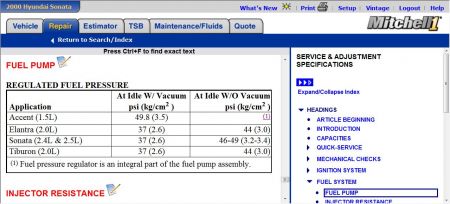
Monday, June 14th, 2010 AT 7:50 AM







